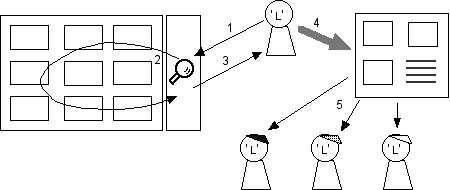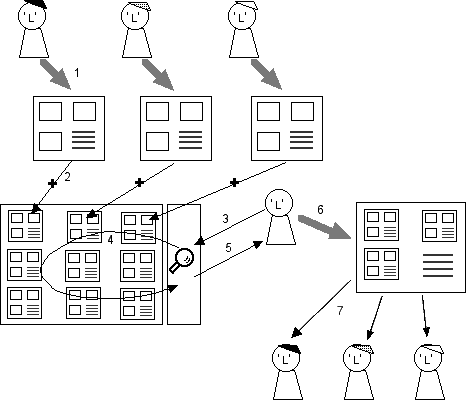Digital meta-collections
View my new website at www.doctordada.com.
Presented at Digital Collections Summit, Adelaide, 2006.
What is “Web 2.0”? There are many definitions on the web, but another way to answer the question is by a set of examples, such as Wikipedia, Flickr, Google Maps, Del.icio.us etc. Another way is with a diagram:

Fig. 1: Web 1.0 (left) versus Web 2.0 (right)
In Web 1.0: Information travels in one direction (outwards). To contribute, you need a server + domain name + HTML skills
In Web 2.0: Information travels in both (or many) directions. No special facilities or skills are required to contribute.
What are the advantages of Web 2.0?
Participation and recognition are strong motivating factors: people usually feel more positively towards an activity if they feel they have contributed something meaningful towards a tangible outcome, and even more so if their contributions are publicly recognised in some way (Muchinsky, 2000). Or, to put it another way:
- Visitors create content. This leads to more content.
- More content leads to a larger audience .
- The larger the audience (potentially) the more contributors and therefore, the more content.
- This creates a ‘virtuous circle’.
So, in a museum context, if a visitor were given the opportunity, not only to select personally meaningful objects from a collection, but to arrange them, write something about their choice and make their annotated arrangement publicly available, it is reasonable to expect the value of that activity for the visitor would be higher than if they were just searching, or making a private selection (Fig. 2).

Fig. 2: Process of creating a public virtual exhibition
Steps 1-3: User searches collection.
Step 4: User draws on collection search results to create sub-collection, with commentary = (virtual) exhibition.
Step 5: Exhibition is made public.
This is the model adopted by the Art Gallery of NSW with its myVirtualGallery. [See Beyond the online museum]
The next step?
Once enough public virtual exhibitions have been created, these could form a sort of 'meta collection', which could then be searched and used to create public 'meta-exhibitions' (Fig. 3).

Figure 3: Process of creating a public meta-exhibition
Step 1: A number of users create exhibitions.
Step 2: Exhibitions are gathered into a (meta-)collection.
Steps 3-5: User searches exhibitions.
Step 6: User creates sub-collection of exhibitions, with commentary = meta-exhibition.
Step 7: Meta-exhibition is made public.
References
Muchinsky, R.M. (2000). Psychology Applied to Work. Belmont CA, USA: Wadsworth, 341-46
Valenza, J. K. (1998). Real art museums without walls. In Technology Connection, Vol. 4 Issue 9, Feb 1998, 10. http://www.kent.k12.wa.us/KSD/KR/LIBRARY/MUSEUMS/museum_school.html (accessed 9 Sep 2005)
